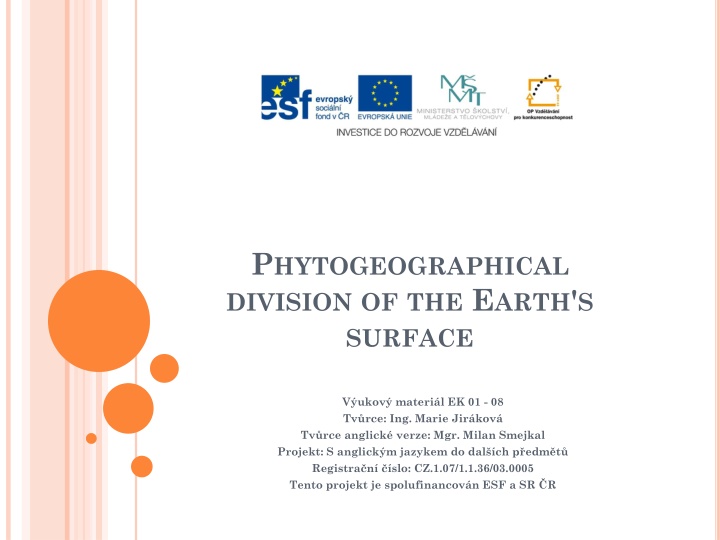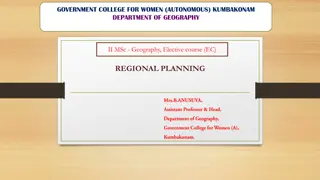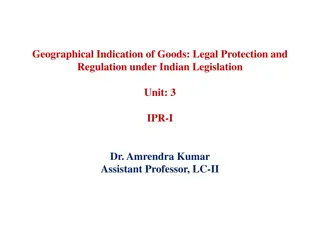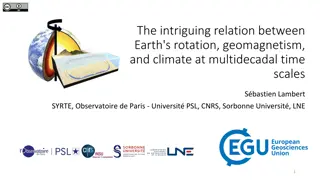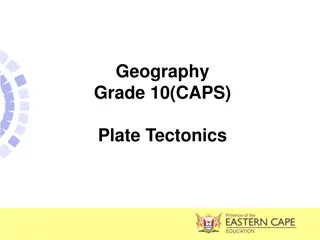Phyto geographical Division of Earth's Surface Exploration
This exploration delves into the phyto geographical division of the Earth's surface, examining vegetation zones, plant areas, and regional phyto geography. It discusses areas like Holarctic, Palaeotropical, Neotropical, Australian, Cape, and Antarctic. The content covers the belt of tropical rainforests, deciduous and semi-deciduous forests, savannah belt, and deserts. It explains the distribution of vegetation based on altitudinal zonation and latitude, showcasing the diverse flora in different phytogeographical areas.
Download Presentation

Please find below an Image/Link to download the presentation.
The content on the website is provided AS IS for your information and personal use only. It may not be sold, licensed, or shared on other websites without obtaining consent from the author.If you encounter any issues during the download, it is possible that the publisher has removed the file from their server.
You are allowed to download the files provided on this website for personal or commercial use, subject to the condition that they are used lawfully. All files are the property of their respective owners.
The content on the website is provided AS IS for your information and personal use only. It may not be sold, licensed, or shared on other websites without obtaining consent from the author.
E N D
Presentation Transcript
PHYTOGEOGRAPHICAL DIVISION OF THE EARTH'S SURFACE V ukov materi l EK 01 - 08 Tv rce: Ing. Marie Jir kov Tv rce anglick verze: Mgr. Milan Smejkal Projekt: S anglick m jazykem do dal ch p edm t Registra n slo: CZ.1.07/1.1.36/03.0005 Tento projekt je spolufinancov n ESF a SR R
VEGETATION OF THE EARTH IS DIVIDED: horizontally plant areas and vegetation zones vertically altitudinal zonation elevation levels
REGIONAL PHYTOGEOGRAPHY examines the various flora phytogeographical areas
PLANT AREAS the highest phytogeographical units divided into sub-regions, provinces
AREAS Holarctic Palaeotropical Neotropical Australian Cape Antarctic
VEGETATION ZONATION an inevitable extension of vegetation depending on latitude from the equator to the poles we can see coherent and parallelly organized VEGETATION ZONES
THE BELT OF TROPICAL RAINFORESTS equatorial regions balanced climate, the average temperature 24- 29 C even abundant rainfalls diverse vegetation, dominated by trees
THE BELT OF DECIDUOUS AND SEMI- DECIDUOUS FORESTS it follows the tropical rain forests on the southern and northern hemisphere temperature differences between the cold season and the warm season irregular rainfalls
THE SAVANNAH BELT tropical and subtropical areas of the southern hemisphere the rainy season 2-4 months the tall grass vegetation, sparsely scattered shrubs or trees
THE BELT OF DESERTS AND SEMI-DESERTS in the tropics, subtropics and temperate regions a small amount of precipitation large temperature differences between day and night very sparse vegetation
THE BELT OF FOREST WITH HARD LEAVES AND THEIR ALTERNATIVE COMMUNITIES. areas with maximum precipitation in winter and very dry and warm summers (eg. California, Mediterranean) original vegetation - evergreen forests current vegetation - scrub communities
THE BELT OF DECIDUOUS BROAD-LEAVED FORESTS. temperate zones of the northern hemisphere winter lasts 3-4 months deciduous trees
THE BELT OF STEPPES in extratropical areas little rain vegetation - grasses, herbs The Central Asia, Ukraine, North America (prairie), South America (pampas)
THE NORTHERN BELT OF CONIFEROUS FORESTS Northern Europe, Asia, North America characterized by large fluctuations in temperature spruce, pine, fir, larch northern boundary of the forest
THE BELT OF TUNDRA a northern hemisphere a short growing season and low summer temperatures mosses, lichens, shrubby birches, willows
WORKSHEET - REVISION How to divide vegetation on Earth? What does regional phytogeography study? What are the plant areas? Which plant areas do we know and what is characteristic for each of them ?
SOURCES KINCL, Lubom r, Miloslav KINCL a Jana JAKRLOV . Biologie rostlin pro 1. ro n k gymn zi . T et , upraven vyd n dotisk. Praha: Fortuna, 2003. ISBN 80-7168-736-7.
